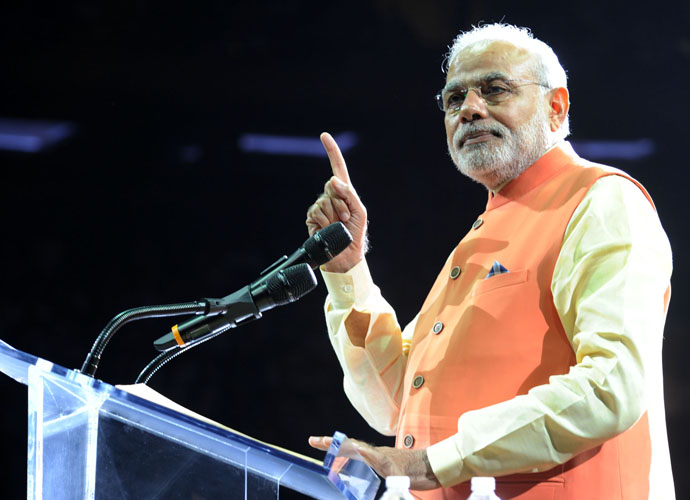Modi has shown the world he can sell the Indian Dream

Prime Minister Narendra Modi’s first year in office, according to some critics, has made him an NRI prime minister rather than an Indian one. The typical complaint here seems to be that he has spent his time being feted by his supporters in the United States, Australia and elsewhere, neglecting his duties to India.
One could, naturally, debate the assumption here that a nation’s interests lie only within its physical borders. However, what is more disturbing is that in an age when a peripatetic global existence is a reality for many in terms of family, work, education and even entertainment, rhetorical distinctions between Indians and Non-Resident Indians (NRIs) are being invoked by Modi’s critics in distracting and divisive ways. To use the title of an important and influential book on the phenomenon, perhaps this has turned into yet one more axis for “Breaking India” talk!
One example, quoted below, appeared to me a little more forcefully stereotypical about NRIs than others:
“That is why the West and the NRI loved him (Modi): he seemed to have internalised all their values and seemed a third-rate version of them. When he talks development, even the West cannot believe that the evangelicals of World Bank and IMF have created such a perfect mimic of the development logic. The NRIs are crucial in a mythical sense here. They create the idea of the split-level Indian. Like Modi, they are all Modis abroad — aspiring, hardworking, successful, easy to please, and willing to learn. Modi is an American in a bandhgala suit. They know that he is playing out the American dream in India. He is the new wog uttering all the right sentences."
 |
| Narendra Modi addresses Indian-Americans at Madison Square Garden in September 2014. |
Beyond this superficial picture of aspirational NRIs and their supposedly aspirational “wog” prime minister is of course a reality that has been completely disregarded here. There might be a bit of truth that politicians talk about things like development and progress in terms middle classes latch on to like airports and factories. But if there is one thing that anyone who has had their eyes and ears (and minds) open will tell you, Narendra Modi has been selling a lot more than a simplistic “let’s turn India into America” shopping mall fantasy.
When Modi spoke at the United Nations, he stepped up for all those who see India as an unbroken civilisation, and one which needs to reclaim its civilisational vision not only for its own sake but for the sake of all of the world which has accepted the destruction of nature as the only way for progress in the last few centuries. This effort is not about going back to a mythic past, as secular critics paint it out to be by magnifying odd comments about flying chariots. It is about the present, and the future.
When he spoke on Teacher’s Day, he invoked not some amusement park fantasy but ideas about children going out to see the sunrise, being healthy, and most of all of restoring the idyllic vision of the “gaav ka masterji”.
When he spoke about helping fishermen, he added the tiny nuance that ornamental fisheries might be useful; a not insignificant concern for growing constituency in India and abroad that views nature and animals not as mere resources but as living sentient beings the human world has unfairly and devastatingly harmed for too long now. And unlike the much publicised beef ban, there is no religious angle here.
(On that note, one might add, he also got China to serve him food in which no animals were harmed.)
What Modi-phobes and NRI-phobes seem to be missing is that there is a constituency for a prime minister who does things like this. This constituency is global, contemporary, and it is profoundly Indian in its civilisational yearning, if not articulation just yet. To try to caricature it as some kind of an NRI aspirational mentality is itself a perpetuation of the caricature that much supposedly critical and secular commentary has become in the face of history and truth in our world today.
And as for the much-maligned NRIs who admire Modi, I have encountered not so much the caricatured elites who want to watch India turn into McAmerica, but something more real, rooted and humbling.
I have seen NRIs who have given up their life savings and retirement funds to ensure that India will one day be accurately studied and taught about in American academia – in the fields that most Indians are too pressured by family or circumstances even bother about like history, social sciences, and theology.
I have seen NRIs from tiny places around the world keeping alive their ancestors’ ways of worship and feeling from the days of indentured labour. They, too, often wonder about this wholesale caricaturing of the diaspora as elitist Hindutva by their brothers and sisters in their ancestral homeland.
I have seen as much of a longing for return among NRIs, as there is the ever-present desire to emigrate among the young in India.
We live in an age of migrations, displacements, and no homes in sight. Beyond the demands of circumstances, economic, political, familial, that take us where we are, there is no loyalty test, no need to judge people for where they live. Yet, some of us who should know better still paint this condescending portrait of the NRI as some oppressor teaming up with Modi to turn India into a mini-America.
One year into his prime ministership, Modi might still have many challenges to deal with in India and abroad. But the least we could credit him and his constituency with is the fact that Indians today perhaps are less interested in an American Dream for India than – and even if it’s just yoga and Gandhi for starters – an Indian Dream for the whole world.

